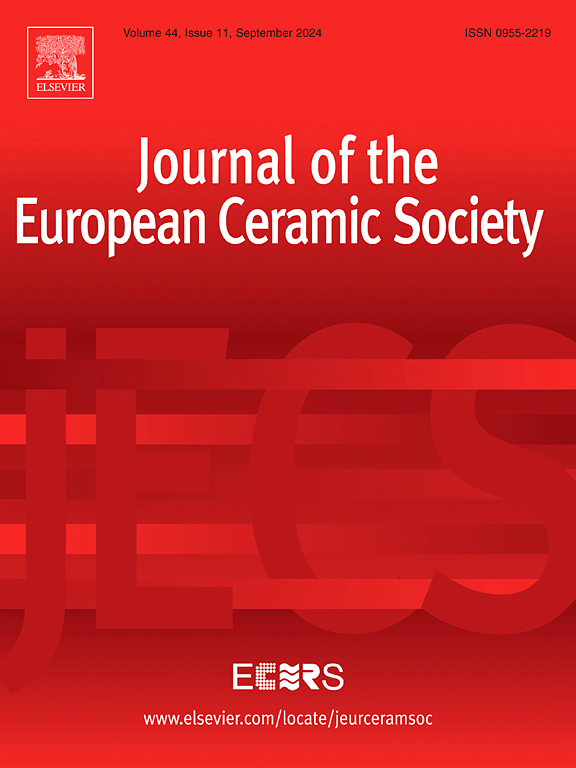原位生长碳化硅纳米线增强六方氮化硼陶瓷
IF 5.8
2区 材料科学
Q1 MATERIALS SCIENCE, CERAMICS
Journal of The European Ceramic Society
Pub Date : 2025-06-06
DOI:10.1016/j.jeurceramsoc.2025.117603
引用次数: 0
摘要
一维(1D)结构,如纳米线、晶须和纤维,因其作为先进复合材料增强材料的潜力而受到广泛关注。在制备高性能复合材料的过程中,如何实现一维结构在基体中的均匀分散,以及如何实现一维结构与基体之间的强界面键合是最具挑战性的两项任务。由于六方氮化硼(h-BN)陶瓷的性质较弱,本研究采用化学气相沉积(CVD)技术在催化剂上原位生长,将SiC纳米线引入到BN粉末中,保证了SiC纳米线在后续h-BN陶瓷中的均匀分散。以掺立方氮化硼(c-BN)的氢氮化硼纳米线与碳化硅纳米线的粉末混合物为原料,采用火花等离子烧结法制备了高性能的氢氮化硼复合陶瓷。新近从碳氮化硼中衍生出的洋葱状h-BN结构在烧结过程中被激活,使SiC纳米线牢固地锚定在h-BN晶粒上。这些碳化硅纳米线分布良好,与h-BN基体结合牢固,通过阻止和偏转裂纹的扩展,显著改善了h-BN陶瓷的力学性能。当催化剂质量比为5.50 wt%时,SiC纳米线的密度、杨氏模量和抗弯强度分别达到2.29 g/cm3、35 GPa和171 MPa,复合性能最佳。本研究为制备高性能h-BN复合陶瓷提供了一种新的组合策略,将进一步促进h-BN陶瓷的发展和应用。本文章由计算机程序翻译,如有差异,请以英文原文为准。
In situ grown silicon carbide nanowires reinforced hexagonal boron nitride ceramics
One-dimensional (1D) structures, such as nanowires, whiskers and fibers, have attracted extensive attentions for their potential as reinforcements for advanced composite materials. To achieve uniform dispersion of 1D structures in the matrix and to materialize strong interface bonding between them and the matrix are the two most challenging tasks for preparing high-performance composite materials. For hexagonal boron nitride (h-BN) ceramics are naturally weak, in this work, SiC nanowires were introduced into BN powders via in-situ grown on a catalyst using chemical vapor deposition (CVD) technology and this technology ensured the uniform dispersion of SiC nanowires in later h-BN ceramics. High performance h-BN composite ceramics were fabricated by spark plasma sintering from as-prepared powder mixture of h-BN and SiC nanowires doped with cubic boron nitride (c-BN). The onion-like h-BN structures, freshly derived from c-BN, were activatory during the sintering process, facilitating the SiC nanowires firmly anchored onto the h-BN grains. These SiC nanowires were thus well distributed and strongly bonded with h-BN matrix, significantly improving the mechanical properties of h-BN ceramics by stopping and deflecting the extension of cracks. Optimal composite performance was achieved when SiC nanowires were grown with a catalyst mass ratio of 5.50 wt%, and the density, Young's modulus and flexural strength of the sample reached 2.29 g/cm3, 35 GPa, and 171 MPa, respectively. This study demonstrates a new combination strategy for the preparation of high-performance h-BN composite ceramics, and will further promote the development and application of h-BN ceramics.
求助全文
通过发布文献求助,成功后即可免费获取论文全文。
去求助
来源期刊

Journal of The European Ceramic Society
工程技术-材料科学:硅酸盐
CiteScore
10.70
自引率
12.30%
发文量
863
审稿时长
35 days
期刊介绍:
The Journal of the European Ceramic Society publishes the results of original research and reviews relating to ceramic materials. Papers of either an experimental or theoretical character will be welcomed on a fully international basis. The emphasis is on novel generic science concerning the relationships between processing, microstructure and properties of polycrystalline ceramics consolidated at high temperature. Papers may relate to any of the conventional categories of ceramic: structural, functional, traditional or composite. The central objective is to sustain a high standard of research quality by means of appropriate reviewing procedures.
 求助内容:
求助内容: 应助结果提醒方式:
应助结果提醒方式:


